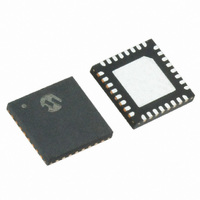MRF89XA-I/MQ Microchip Technology, MRF89XA-I/MQ Datasheet - Page 66

MRF89XA-I/MQ
Manufacturer Part Number
MRF89XA-I/MQ
Description
TXRX ISM SUB-GHZ ULP 32QFN
Manufacturer
Microchip Technology
Specifications of MRF89XA-I/MQ
Package / Case
32-WFQFN Exposed Pad
Frequency
863MHz ~ 870MHz, 902MHz ~ 928MHz, 950MHz ~ 960MHz
Data Rate - Maximum
200kbps
Modulation Or Protocol
FSK, OOK
Applications
ISM
Power - Output
12.5dBm
Sensitivity
-113dBm
Voltage - Supply
2.1 V ~ 3.6 V
Current - Receiving
3mA
Current - Transmitting
25mA
Data Interface
PCB, Surface Mount
Antenna Connector
PCB, Surface Mount
Operating Temperature
-40°C ~ 85°C
Number Of Receivers
1
Number Of Transmitters
1
Wireless Frequency
863 MHz to 870 MHz, 902 MHz to 928 MHz, 950 MHz to 960 MHz
Interface Type
SPI
Noise Figure
- 112 dBc
Output Power
- 8.5 dBm, + 12.5 dBm
Operating Supply Voltage
2.1 V to 3.6 V
Maximum Operating Temperature
+ 85 C
Mounting Style
SMD/SMT
Maximum Data Rate
256 Kbps
Maximum Supply Current
25 mA
Minimum Operating Temperature
- 40 C
Modulation
FSK
Lead Free Status / RoHS Status
Lead free / RoHS Compliant
Memory Size
-
Lead Free Status / Rohs Status
Lead free / RoHS Compliant
Available stocks
Company
Part Number
Manufacturer
Quantity
Price
Company:
Part Number:
MRF89XA-I/MQ
Manufacturer:
MICROCHIP
Quantity:
12 000
3.4.4
The second mixer stages are followed by the channel
select filters. The channel select filters have a strong
influence on the noise bandwidth and selectivity of the
receiver and hence its sensitivity. Each filter comprises
a passive and an active section.
3.4.4.1
Each channel select filter features a passive
second-order RC filter, with a bandwidth programmable
through the PASFILV<3:0> bits (FILCREG<7:4). As the
wider of the two filters, its effect on the sensitivity is
negligible, but its bandwidth must be set up to optimize
blocking immunity. The value entered into this register
sets the single side bandwidth of this filter. For optimum
performance it should be set to three to four times the
cut-off frequency (fc) of the active Butterworth (or
Polyphase) filter described in Section 3.4.4.2 “Active
Filter”, and as shown in Equation 3-8.
EQUATION 3-8:
FIGURE 3-6:
FSK mode: The 99% energy bandwidth of an FSK
modulated signal is approximated, as shown in
Equation 3-9.
EQUATION 3-9:
The BUTFILV<3:0> bits from FILCREG set the cut-off
frequency (f
FSK lobes are centered on the virtual “DC” frequency.
DS70622B-page 66
MRF89XA
3 f
•
c ButterFilter
CHANNEL FILTERS
c
-f C
) of the filter. In a zero-IF configuration, the
BW
Passive Filter
99%,fsk
≤
BW
ACTIVE CHANNEL FILTER DESCRIPTION
=
passive,filter
2
•
Polyphase filter for OOK (POLFILEN = 1)
-f o
f
dev
Low-pass filter for FSK (POLFILEN = 0)
≤
-f C
+
4 f
•
BR
------ -
2
c
ButterFilter
Preliminary
0
0
3.4.4.2
The “fine” channel selection is performed by an active,
third-order, Butterworth filter, which acts as a low-pass
filter for the zero-IF configuration (FSK), or a complex
Polyphase filter for the low-IF (OOK) configuration. The
POLFILEN bit (SYNCREG<7>) enables or disables the
Polyphase filter.
Figure 3-6 illustrates the required bandwidth of this
filter varies between the two demodulation modes.
The choice of f
signal falls in the filter bandwidth, anticipating the Local
Oscillator
temperature and aging of the device as shown in
:Equation 3-10
EQUATION 3-10:
Figure 3-11 illustrates an accurate overview of the filter
bandwidth vs. setting.
the polyphase filter
Canceled side of
f C
frequency
Active Filter
2 f
•
c
should be such that the modulated
c
>
BW
© 2010 Microchip Technology Inc.
99%,fsk
drift
+
over
LO
drifts
the
f requency
f requency
operating












